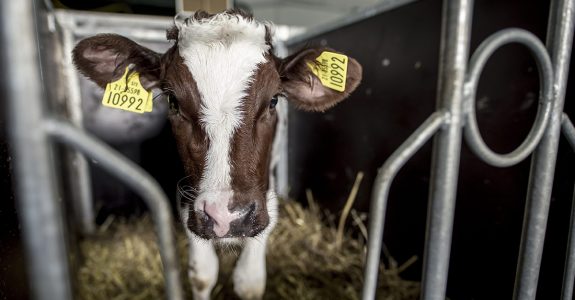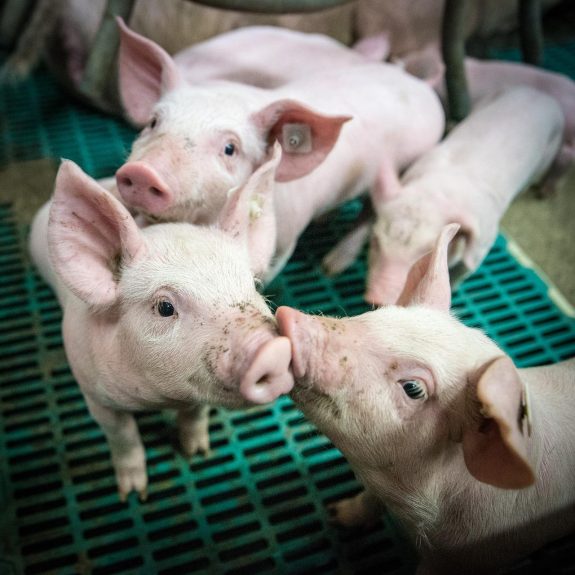Farmed animals in Canada suffer on a scale that is difficult to imagine. In 2023, over 859 million land animals were killed for food in Canadian slaughterhouses. The total number is unquestionably higher, because government statistics don’t include the millions of animals who die in transport en route to slaughter each year––or who arrive so sick or injured that they must be killed upon arrival. Official numbers of farmed animals killed also never include aquatic animals. Aquatic animals are measured by weight rather than counted individually, making it impossible to know how many were killed, only that hundreds of thousands of tonnes of shellfish, and farmed and wild fishes are killed each year.

Animals on modern farms experience horrible suffering during their short lives. Small family farms are largely a thing of the past, most of the animals raised and killed in Canada are chickens raised for meat. They are kept inside dark, windowless barns and are bred to grow so big, so quickly, that they often die of heart or respiratory problems at just a few weeks of age while they are still peeping like chicks. At just six weeks old, they are sent for slaughter.
Other farmed animals spend their lives in heartbreaking intensive confinement systems, such as gestation crates for mother pigs forced to breed, and battery cages for egg-laying hens. Some intensive confinement systems have been the subject of retail bans, forcing industry reforms. Yet these industries have fought hard to continue these practices in only slightly less restrictive ways, for example, by using so-called “enriched” cages for laying hens, which offer a negligible amount more space per bird and do not resolve many of the inherent welfare problems caused by permanently confining animals in cages. To keep their level of milk production high, cows in the dairy industry are forcibly impregnated throughout their lives. Their newborn calves are always removed from them a few hours or days after birth, which is well-documented to cause mother and calf severe distress.
These hundreds of millions of animals benefit from no on-farm legal protections during their lives. While voluntary, industry-written codes of practice exist, they are weak documents with no independent enforcement or verifications mechanisms.
Many standard and “generally accepted” farm practices are exempt from provincial animal welfare laws, meaning that practices that would be illegal if done to a dog or cat are completely legal when done to a pig, cow, chicken, or other farmed animal. This includes causing pain and distress, and cruel confinement housing like battery cages for hens, or gestation crates for pigs—practices widely recognized as some of the most inhumane aspects of industrial farming. Letting farms make up their own rules is a giant loophole, leaving farmed animals in Canada vulnerable to many egregious practices that are “generally accepted” within industry circles. Farms are also often exempt from environmental laws like Canada’s federal price on carbon, nuisance laws, labour and employment laws, and much more.
There is no inspection system in place to monitor welfare on Canadian farms. Unless a complaint is made against a farm –– unlikely, given that farms are usually far from main roads and the majority of animals are kept in windowless barns –– most farmed animals will never have their welfare verified by any third party. Yet when undercover investigations have been carried out in Canada, they have shown shocking, illegal abuse, as well as pervasive suffering under conditions that are considered legal. This is a trend on industrial farms around the world: when investigations take place on randomly selected farms, horrendous animal abuse is always uncovered.
Suffering is an inevitable by-product of the industrial farming model, which attempts to produce the most output with the least amount of input. Workers are often poorly-trained or themselves exploited, yet when investigations reveal unacceptable treatment of animals, owners and companies are quick to point the finger at “one bad actor” rather than to acknowledge that these systems are designed to fail animals on a daily basis. It is the cost of doing business.
Worryingly, US-style “ag gag” laws, which criminalize undercover investigations on farms and slaughterhouses, and increase penalties for trespassing, have now arrived in Canada. In Alberta, Canada’s first ag gag law was rapidly pushed through in late 2019, and Ontario passed its ag gag law in 2020—which outlaws undercover exposés and punishes people who document animal suffering inside transport trucks when they arrive at a slaughterhouse. Farms and slaughterhouses already conduct their operations shielded from public scrutiny or legal accountability. Ag gag laws seek to shut down the only recourse left to show the reality of what goes on behind barn doors: investigations by advocates and whistleblowers. Animal Justice is challenging Ontario’s ag gag law in court.
There are no federal laws protecting animals on farms. Given that animals can cross provincial borders several times in their lives, and in order to create one clear set of enforceable requirements, Animal Justice is calling on the federal government to mandate enforcement bodies proactively investigating and inspecting animal agricultural facilities, and non-compliance should be prosecuted.
Banner: Jo-Anne McArthur | We Animals Media




